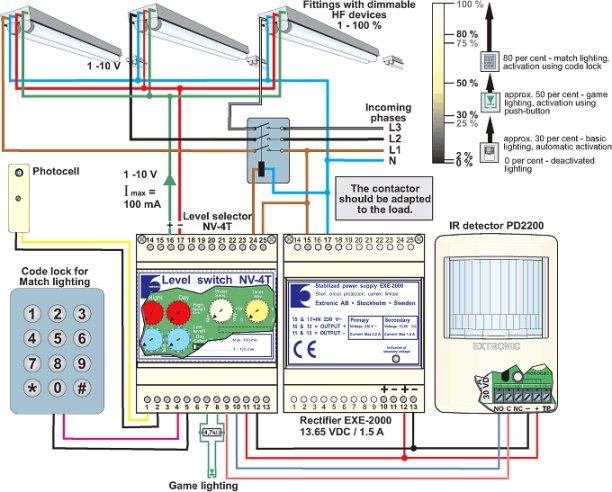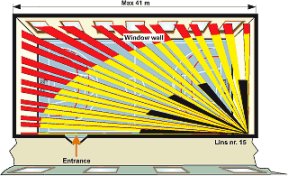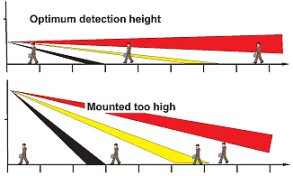5C. Sports hall with IR detectors
Dimmable HF operating devices and three levels
| The premises
This example shows a sports hall with daylight ingress through a number of windows. The hall has an entrance and has no folding partition for subdivision. It is used for various types of activity ranging from exercise gymnastics to for indoor bandy and handball league matches. The various activities do not require equally strong lighting, so an installation with three lighting levels has been fitted: approx. 30 per cent – basic lighting/exercise lighting (automatic activation) Light sources The fittings in the hall have dimmable HF operating devices. We recommend that the number of fittings be overdimensioned so that match lighting can be adjusted to 80 per cent. There are several advantages to this solution:
|
Control system
The control system is based on the NV-4T level selector with a 4.7 kO resistance between contact units 7 and 8. (The resistance connects up the ‘sports hall function’ in the NV-4T.) Presence in the hall is detected by a PD-2200 IR detector with Lens No. 15 (41*41 m). Upon entry into the hall the basic lighting is switched on by the IR detector if the natural light from the windows is insufficient. This is controlled by a light sensor that measures the light in the hall and blocks activation if the light is sufficient. If the activity in the hall requires more light the lighting can be switched on in two further stages. Game lighting is switched on using a pulse-generating push-button. Renewed pressure on the button switches the lighting off. It should not be possible for just anyone to activate match lighting, thus a code lock or key switch is used. When the presence ceases the lighting is completely switched off after the delay (5 – 7 minutes) set in the IR detector. The game lighting and match lighting can be switched off manually using the push-button or code lock. With all deactivation the fluorescent tubes remain switched on at a level of about 2 per cent for about 15 minutes (adjustable) before they are completely switched off. Positioning of detector Positioning of the detector is crucial to the function! The example below shows how the detector should be positioned. With this positioning optimum detection is achieved upon entry, and the detector does not look out through the entrance, which means the lighting does not remain switched on when someone passes by outside. The detector is positioned in the corner furthest away from the entrance at a height of 2 – 2.5 m. The mounting height is very important to reliable detection. Mounting too high up can result in relatively large areas with poor detection. A protective grating is used for corner mounting to protect the detector against balls etc. |
||||||||||||||||||||||||
 |
|||||||||||||||||||||||||
|
Information for current budget
|
|
||||||||||||||||||||||||

|
|||||||||||||||||||||||||
Use of sports hall on a day in October
|
|
||||||||||||||||||||||||








